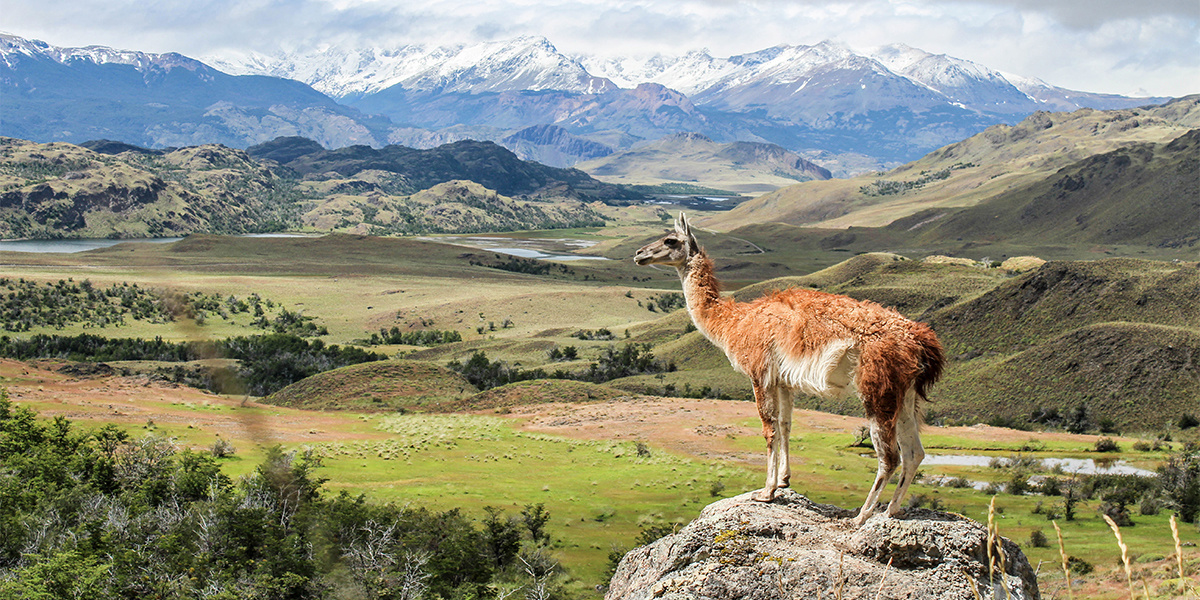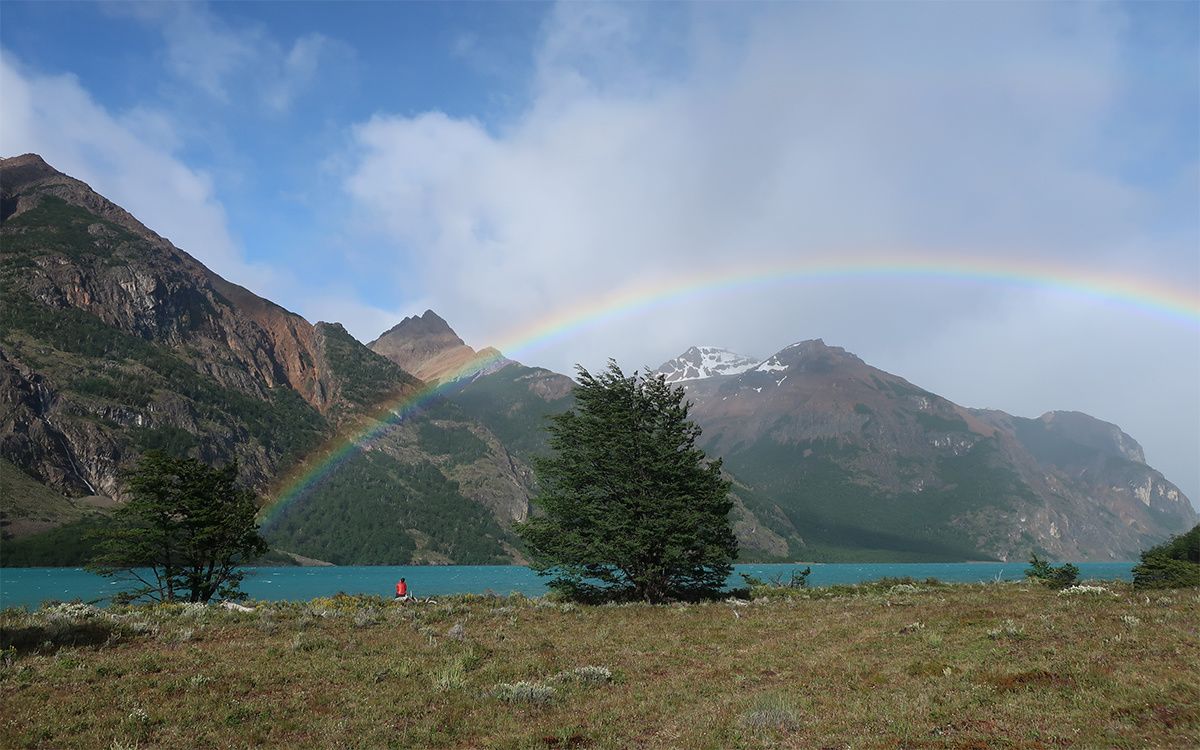

By Robin Walter
After fording a rib-deep and bone-cracking cold river whose current could have easily swept away a person much bigger than I am, I took stock of my surroundings. My companions and I were sodden and soggy, huddled against slanting hail on the banks of the Jeinimeni River in Patagonia. Miserable? You bet. But there were also huge grins plastered across all of our faces. Exhilarated? Yes. Joyful? Plainly. Through rivulets of water cascading down rain-jacket hoods, I registered a few shell-shocked expressions. Everyone seemed to be chewing on the same question: How in the hell did I end up spending Christmas morning with frozen feet?
Later that night, we huddled around a fire in a sheep-shack tucked into a lenga forest on the edge of Valle La Gloria, sang rousing rounds of “Rudolph the Red-nosed Huemel” (that’s the endangered deer that lives in the southern Andes), and considered why we had travelled thousands of miles by plane, ferry, bus and truck to spend Christmas in Patagonia’s backcountry.
Nadine Lehner
Each of the 10 team members had signed up to spend nine days trekking through Patagonia’s Aysén region with Chulengo, an expedition-centered company that aims to reconnect us with the wilds of the natural world and to challenge us to think hard about our roles as advocates for a healthier ecological future. Some came seeking adventure. Others came to foster a connection with self through challenge. Yet others hoped to reconnect with a part of themselves that had been put on the backburner. I had visited Patagonia years before, and came back to help lead the trip as if pulled by the force of a magnet.
Nadine Lehner
The symphonic peaks and endless steppe drew me back to Patagonia, but it was also something else. I think it had something to do with Patagonia’s power to decenter you, to render you insignificant, to destabilize your sense of importance. Its sheer scale—the magnitude and improbability of its angles, the electric green barba de viejo moss strung across its trees—forces a shift in perspective. There’s something both alluring and a little scary about allowing your sense of self to crack apart.
Patagonia’s landscape has long held such power; now, it also enjoys new legal protections. In late January, Chilean president Michelle Bachelet signed into creation two massive new National Parks in the country’s rugged south: Pumalín and Patagonia National Parks. Together, the new parks will preserve nearly 10 million acres of wildlands, an area three times the size of Yosemite and Yellowstone National Parks combined.
The creation of Patagonia National Park is one of the biggest conservation success stories in history—and it’s as controversial as it is ambitious. The vision for the park has been spearheaded by American conservationist Kristine Tompkins and her late husband Doug Tompkins (co-founder of The North Face clothing company), who donated 1 million acres of private land to the park. The new National Park represents a monumental shift in how humans will interact with this landscape. As such, the project has sparked furious debate. Some people have resisted the conversion of rangeland to wilderness preservation, while others have embraced this evolution.
“The way you understand the region’s history impacts how you conceptualize its proper use,” Nadine Lehner, co-founder of Chulengo and former executive director of Conservación Patagonica, told us around the fire that soggy Christmas night.
Consider, to take just one example, the Jeinimeni Valley through which we were trekking, which makes up the northern extent of the new Park. It has only existed as a national reserve for the last 20 years. Before that, settlers utilized the area for agricultural, often to graze sheep. In pre-Columbian times, the nomadic Tehuelche people inhabited the area, traveling to the highlands to hunt game. Each of these periods marks a shift in humans’ engagement with the landscape. Each has had a different impact.
The word “Patagonia” evokes images of wildness. Many think of Patagonia as an icon of the last “untouched” places. Words like untrammeled and unspoiled, virgin and pristine, punctuate descriptions of the place. Is Patagonia wild? Absolutely. The landscape boasts snow-scoured peaks, hanging glacial lakes, and unfathomably blue waters. Is it untouched? Parts of it. Is it wilderness? That’s a loaded question.
[facebook https://www.facebook.com/EcoWatch/videos/10155114746581479/ expand=1]
The fact that we took refuge on Christmas evening beneath the leaky roof of a refugio once used by sheep herders to graze their flocks speaks to the complexity of those questions. To arrive at our camp, we bushwhacked across thorny understory in shin-deep mud and waded through waist-deep rivers clean enough to drink from. The sound of glaciers pouring melt-water through rock made up the soundscape.
It was easy to imagine this place was remote enough to have eluded human impact. But the romanticized notion of it being “untouched” dissolved as we took shelter beneath the tin roof built by shepherds in decades past.
“[Ranching] has been so much more than just an economic center in the region,” Lehner said. “Ranching has been both the primary economic activity and the cultural identity for a very long time.”
In an effort to re-wild the Valle Chacabuco landscape, which now forms the centerpiece of the new Park, Conservación Patagonica removed 25,000 sheep, 5,000 cattle, and 400 miles of fence, moving what once was Chile’s third largest sheep ranch out of production and into conservation.
“If you go around the region and ask people what they love about this place, the word that comes up over and over is ‘tranquilidad’ or ‘calmness,'” Lehner told us. “Tourism is a complicated game because it has the potential to disrupt that.”
Independently of the park’s creation, the region has undergone vast changes. The road into the area is improving, and 3G reaches more places than ever before. The region’s tranquility will evolve regardless of an increase in eco-tourism. By affording protection to an area that might otherwise have faced development, the park may ultimately play a role in safeguarding the region’s tranquilidad, though it may look different than in years past.
Linnea Bast
The morning after Christmas, I woke early to head to the river where I watched the sun slide across the water braiding down the valley. A Magellan goose regarded me through inky eyes as she herded four chicks into the water. Across the river, a waterfall cascaded into glacial moraine. The spray caught the sun and threw a shimmering brocade of light onto slick black rock.
Enormous forces created this place: glaciers had carved entire valleys as rivers moved tons of rock. I thought about home, and what it means to feel at home in a wild place. How do we foster a sense of belonging—not of the natural world belonging to us, but of us belonging to the natural world?
One answer: Create experiences that remove the boundaries that ordinarily stretch between us and the natural world. Take away the cars, phones and faucets. Take away the beds that separate our backs from the ground. Invite our bodies into the presence borne from plunging into glacial lakes. Dissolve the distance that spreads between us and our human-as-animal selves.
“I hope that our generation comes up with a new word for conservation,” Lehner said the night before as the fire died. “Because it’s easy to think that conservation ends with creating national parks, when really it’s just the beginning. We’re standing on the shoulders of giants to be able to walk in these places, and the work each of us needs to do when we walk away from them is different. To borrow a phrase from Doug Tompkins, ‘It is important to consider how each of us will pay rent to live on this planet.'”
For each of us, this work will manifest in diverse ways. Lehner’s exhortation sounded to me like an invitation to dig into. So I dove head first into the river. I shocked my body into the present and allowed my tangled thoughts about wilderness to turn toward the reality of the present: shivering, cold and at home in a truly wild place.
WHERE The Avilés Trail, Patagonia National Park, Aysén, Patagonia, Chile
GETTING THERE It’s not easy to get really far away. From the Chilean capital of Santiago, fly to Balmaceda. Make your way to Coyhaique, take a bus to Puerto Ibañez, catch the ferry across Lago General Carrera to Chile Chico, and find a kind soul to take you across Patagonia’s eastern steppe to the trailhead at Lago Jeinimeni.
WHEN TO VISIT The window between November and March is your best bet—though expect to be hailed on any time of the year.
CAMPING You’ll find puestos—or lean-to’s—along the route that offer varying degrees of shelter. Fires are not permitted outside these structures. Leave your iodine and water filters behind; the water here is as clean as you’ll ever find.
SURVIVAL TIPS Know proper river-crossing techniques. Bring trekking poles to help in deep crossings. Make sure to buy a copy of Map for Good’s recently completed topo map of the area, and know how to read it.
WHAT TO WEAR Don’t forget your gaiters! You’ll be able to gloat when your bare-legged companions spend hours picking burs out of soggy socks.
ADDITIONAL INFO Read about Tompkins Conservation’s work to protect ten million acres—an area the size of Switzerland—here. Want to experience a polar plunge in one of these parks for yourself? Sign up for a Chulengo expedition here.
Reposted with permission from our media associate SIERRA Magazine.

 233k
233k  41k
41k  Subscribe
Subscribe 


